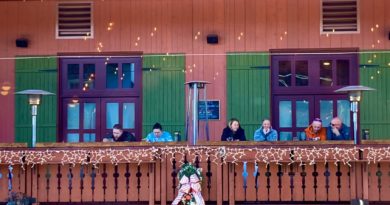This Skiing was Epic
I thought it sounded awesome. My cousin, Rich, was a professional ski patroller for several years at Sun Valley. I could get paid for skiing and use the money to pay for college! So, I took winter quarters off from school and patrolled at Hyak, a small area east of Snoqualmie Pass. There were three of us to patrol both sides of the mountain. The area operated from 9am – 10:30pm during the week, and we were expected to be on the hill from 8am – 11pm every day. We literally skied 14 hours a day. In between we also climbed lift towers to run communication cables and change sheave tires, gave breaks to the chair lift attendants, and swept the hills at night. In slow times we practiced repelling from chairs and other lift rescue procedures. On Saturdays I would move up the pass to ski instruct for cousin Rich’s South Kitsap Ski School.
The first part of the season was always the roughest. It was like a marathon. I had to pace myself the first two weeks while I got my ski legs back and acclimated to the altitude. No one got a day off because they were sick or hurt or sore all over. It was strap on the skis and go, no matter what. We always skied at a pace that could get us through 14 hours and be able to get up and do the same thing again for four more days. So, we rarely blasted down runs at the limit. We kept our effort dialed back to about 80%. When the snow was good, we could count on the flashy ski instructors to come out first thing and tear it up for two hours. Then they would head on in to teach an easy lesson or two. We called them flashes in the pan. We were always out there – skiing, skiing, skiing. Hauling someone off the hill, taking the toboggan back up and skiing some more.
The Best and the Worst
Those days (the early seventies) were the beginning of freestyle skiing. Guys doing aerial tricks like helicopters and back flips off jumps and cornices, and mastering simple tricks like Royal Christies and 360s and skiing mogul fields as fast as possible with as many turns as possible. There was no science or gymnastics to it at all. These boys were totally winging it, as evidenced by Guy, the wildly bearded fellow I met on the slope one day. We talked a bit, he gave me his little freestyle skiing trick book and then took off straight down the hill standing straight up, yelling ‘yahoo!’ the whole way down. I have never seen anyone ski so fast standing so straight up. It was crazy.
We skied in white outs, through avalanches, temperatures as cold as 30º below zero and weather as extreme as 10º below with winds blowing up the hill at over 60 mph. We fought off frostbite, skied into back country to rescue people off cliffs, injected diabetics who were going into insulin shock, drove injured skiers with dislocated shoulders to the hospital, and splinted and hauled compound leg fractures off the mountain in toboggans. And we often did it alone.
There were times we skied in some of the most incredible conditions, like bottomless powder – fluffy snow up to eight feet deep! The 1973-74 season in particular was a winter of epic snowfall. I think our snow pack was 386” that winter. Actual snowfall can be two or three times that. In one five-day stretch we got 108”. Every morning we were shoveling our way out of the patrol building with two or three feet in front of the doors. It made for unbelievable skiing and the passes were so overwhelmed with snow very few people could make it to the ski areas to experience it. So, we often had it almost all to ourselves.
It was the best kind of skiing there was – one of the nearest things to an out of body experience I can think of. To find it people sometimes succumb to irrational exuberance. That siren’s song can easily overcome reason and lure people over the ragged edge of danger into avalanche country – the land of no return. In avalanches some people get very lucky and survive. Others do not. It’s patrollers who get to rescue those people, alive or dead.
On average, the Pacific Northwest has more avalanches each winter than any other part of the world. We don’t generally have the spectacular light snow avalanches seen on TV from the dry Rockies. We get all kinds here. Most or ours are the result of heavy snowfalls and temperature changes that create unstable layers and stratification.
Most people have never been in an avalanche, so few realize how heavy, fast, powerful and inescapable one can be. They are like an ocean undertow of uncured concrete. Once you are in it, there’s no getting out. They can travel at well over 100 mph, so outrunning one is futile. Simply being able to keep your skis on is a feat. Once it has jettisoned your skis, you usually end up swimming like a madman to keep your head out of the mass of concrete. About your only protection is a tree line and even then, God help you. If it’s one of those fine Rockies powder avalanches, chances are you will suffocate from inhaling the fine snow crystals before you are ever buried, as it will fill and pack every orifice you have.
I have only been in two avalanches and they were small by most standards. As patrollers, we would occasionally dynamite or ‘ski out’ an avalanche area. When we did that, all three of us would go together. The couple times we set them off, I somehow managed to keep my skis on and ski them out, one to a bordering tree line. After the adrenalin rush, the second one had what we thought afterward was a funny turn. While we two underlings managed to keep our feet and escape, our fearless (and somewhat idiotic) lead patroller, Greg Petterman, got buried up to his neck. We extricated him but, laughing and finger pointing the whole time, never let him forget he would have been in deep do-do if it weren’t for us.
The Need for Speed
During the course of a season there were stretches where the snow wasn’t special and the weather didn’t cooperate – it was like the dog days for the boys of summer. Over those periods we would think of different ways to spice things up.
Ever wonder what it’s like to ski at downhill racing speeds? So did we, so we decided to find out. On a slow day Gary, a couple of the club racers and I set up three control gates down the front face. From a standing start just below the top of the mountain, we would set off one at a time meeting again at the bottom after passing over two mogul fields, through the three gates, and dropping 1,200 vertical feet over a run of about 3/4 of a mile. We started at about 3/4-speed to get used to the track, then gradually started holding a tuck longer and longer, driving ever-increasing speeds over the snow.
Running hard like that over mogul fields I should have been using 220 cm downhill skis. Instead, I stayed with my trusty 207 cm slaloms mainly because I couldn’t afford another pair of skis and I wasn’t going to risk breaking someone else’s. Those 207s made it a bit acrobatic at times, with the skis sometimes bouncing from tip to tail as I tried to hold the edge across the fall line. Too much traverse in a mogul field and you risked losing it. Without a helmet that was probably not a good thing. Too much fall line and the same nasty fate awaited. But when you skied 14 hours a day, it literally became more natural than walking. I could feel every clump of snow, every change in the surface – its slipperiness, grain, grip, and texture. Those stainless steel edges were extensions of my toes and the soles of my feet. The boots transfer every undulation as you constantly modulate the edges to accommodate instantaneous changes in terrain. It all works together, seamlessly, flawlessly – until you make a mistake in judgment.
Like anything at that speed, there is very little if any thinking. Thoughts are one or two very fleeting words – stay high, hold it, glide. In fact, thinking usually means you’re going down. You figure out what your going to do before you go. Over the days, I finally calculated the run length and we started timing each other. Average speeds from a standing start were 82 mph, with an estimated top speed of 88. We did that several times a day for about two weeks, before we even got bored doing it. That’s when I understood how and why people are capable of doing extreme things. When you live for doing something and you get used to being at the edge, the level of mastery and accomplishment is simply higher than others can imagine.
Pig Roasts & Alarm Clocks
Gary Cranston was a couple years younger than me and pretty much on the crazy side. He was a fun-loving goofball who worked as little as possible and skied as much as possible. One day we were skiing powder in the glades, bombing along and having a great time. Up ahead I could see a little depression in the snow. It seemed no big deal. But suddenly, I realized it was a hot spot – twelve feet deep with a stream at the bottom. There was nothing left to do but try to carry as much speed as possible and leap over it. This one happened to be big, almost seven feet across. Turned out it was big enough to keep me from making the other side, but not too big to prevent my skis from bridging its mouth and turning me upside down like a pig on a bbq skewer. Just like that there I was, unceremoniously suspended upside down, my head about 5 feet from a nice little gurgling stream. To make it worse, Gary came skiing up and immediately doubled over with laughter. “Well,” he said, “looks like you’ve got a bit of a problem. You know you look pretty stupid just hangin’ there.”
“Thanks.”
He looked at his watch. “Hey, it’s lunchtime. I’m hungry. I’ll see you later!”
“Seriously?”
Off he went, laughing the whole way. And there I was, just hangin’ out….
It took me twenty minutes to dig out. I didn’t want to get my feet wet, because I still had to be on the hill for several more hours. I managed to reach up, undo one of my bindings and jam my boot into the side of the hole. Then, bracing myself, I reached up again and released the other binding, quickly jamming my second foot into the side while launching my back into the opposite side. I flipped myself around and climbed out by hanging onto my skis while jabbing my feet higher and higher into the walls of the hole until I could crawl out. Then I skied down for lunch. Gary laughed at me again when I got there.
Gary also had an old fashioned alarm clock, the 1930s round bodied, analog style with stubby legs, dual bells and a hammer on top, and a manual spring winder on the back. I hated loud alarm clocks, and this thing was LOUD. He would set it every night, and every morning that damn thing would sound off like reveille. We slept in sleeping bags on the hospital beds in the patrol’s first aid building. I was several beds away from him on purpose. That damn clock would go off and ring and stammer for like 30 seconds until I could barely stand it. Gary would finally and suddenly lurch upright and launch that clock across the room where it would always meet a plywood wall. Falling to the floor, sometimes the clock would keep going, sometimes it would stop and sometimes it would hesitate – for a moment. Then, inexplicably, it would spontaneously start up again, spitting and sputtering, jumping about on that hammer and those bells, spasmodically clinging to life. Eventually, it would either stop by itself or Gary would get up and fetch it. Every morning was the same. You would think one day that clock would mercifully give in to mortality, but no. It never broke. If ever there was a clock powered by the Timex mantra, this was the one; it took a licking and kept on ticking. It was eerie, as if it actually had a life of its own.
Off to the Reservoir
Of the duties we had other than patrolling the hill and attending to the wounded, I hated climbing the water tower the most. Even climbing chair lift towers was better than this, and that was saying something. The water tower fed the whole ski area. It was a concrete cylinder with, get this, a flat roof. It had the exact proportions of a beer can, so local breweries took turns painting it with their labels. Because of the flat roof we had to climb it and shovel the snow off the top. I’m not sure how the ski patrol got stuck with that duty, but there you go.
The only way up was a ladder anchored down the side of the can made from 1/2”-diameter rebar – cheap, but very hard to hold onto. I guess there was an assumption no one would be climbing it unless there was at least 4 feet of snow pack because the rungs didn’t start until at least 10 feet up. So even with a good snow pack, you had to reach or jump to grab the first rung. Then you had to pull yourself hand over hand up the ladder until your feet could catch the first rung. This wearing full gear and ski boots.
But the best part was still to come. Typically, this thing was only climbed after a good snow. That also meant there was snow and ice on the ladder rungs. Ever tried to climb an ice-ladened ladder with ski boots? Better still, the rungs were that really skinny 1/2” rebar and they didn’t extend far enough out from the wall to get much more than ski boot toes on it. You had to be really careful climbing that thing because a couple of slips were inevitable. Once on top of the 45-foot tower someone was at least thoughtful enough to have left a shovel. It was only a 15-minute job, but it threatened to kill me every time I went up or down.
I skied in all kinds of the most fantastic and awful weather imaginable. Fourteen hours a day, five days a week, and instructing on the sixth day added up to well over 100 days and 1,400 hours a year of skiing. Being a pro ski patroller was essentially not much more than a ski bum with responsibilities. But responsibilities change everything, don’t they? I learned to be empathetic but focused in emergency situations while still helping people. Ski, eat, sleep, help people. That’s what I did. And I loved it.




